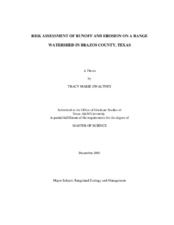| dc.description.abstract | A drip type rainfall simulator and an existing watershed study were used to assess relationships between runoff, infiltration, erosion and associated risk thresholds on a range watershed in Brazos County, Texas. The focus of the research was determining erosion risk associated with seasonal variations in precipitation and vegetation. The objectives were to (1) develop a climatic profile for Brazos County, Texas, (2) evaluate relationships between vegetative cover, infiltration, runoff, and climatic events, (3) quantify erosion/ runoff risk associated with measured vegetation, soil moisture, and climatic events, and (4) identify potential managerial thresholds for erosion risk management on similar range watersheds. The current year climatic profile showed the wettest season was summer with thirty-two percent of the precipitation coming from one rainfall event. Also, October through December was higher than the long-term rainfall average. Pair wise correlations identified season, initial time to runoff, percent litter, annual as the dominant species, soil moisture, amount to runoff and amount to storage as significant (p<0.05) variables affecting runoff and infiltration. Percent saturation and annuals as the dominant species were significant variables affecting sediment yield. During the current study, seasonal variations in precipitation patterns influenced runoff, infiltration, and sediment yield. Spring and summer had the highest infiltration rates while the largest runoff events were in fall and winter. The highest percent of soil saturation coincided with the largest runoff and sediment losses.
Minimums of two centimeters (winter and fall) and three centimeters (spring and summer) initiated runoff. This rainfall threshold would be exceeded 20 percent of the time based on the climatic profile developed for Brazos County. Peak biomass production for the watershed site was 170.61 g/m2. This was above the recommended biomass threshold of 134.5 to 168.1 grams/m2 to minimize sediment loss for tallgrass rangeland. Annual sediment loss was 10.8 grams/m2, which is negligible. Additional research across a wider array of site variation is needed to identify appropriate thresholds for the Post Oak Savanna ecosystem. | en |


